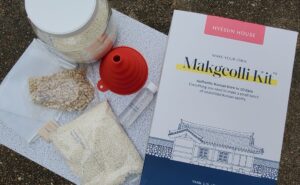Autumn Leaves
Fall is arguably the most beautiful season in Korea. The air is crisp, the streets are blanketed in aromas of roasting chestnuts, and summer greens are replaced by gorgeous autumn hues. Of the colors of fall, shades of orange – tawny, tangerine, mahogany – seem to be most prominent. The season itself is short, but for a few precious weeks, the colorful leaves transform the country into a memorable spectacle for the eyes.
Jjimjilbang Pajamas
Being naked in public isn’t everyone’s cup of tea. Still, there’s no doubt that the jjimjilbang, or public bath house, is an important institution in Korean culture… not to mention fun and relaxing, if you’re willing to be adventurous and step out of your comfort zone.
While the sex-segregated hot spring tubs might be the main draw, common areas provide a great number of amenities like internet cafes, food courts, and sleeping nooks. Visitors wear provided pajamas in these areas, which are often a rather unflattering, but recognizable shade of sherbert orange.
Burning Coals
A trip to Korea would not be complete without an evening of barbeque. In addition to offering delicious food, the gogi-jib (bbq restaurant) is the ideal setting for social outings.
Here, slabs of samgyeopsal (pork belly) and galbi (ribs) are served with plates of unlimited banchan (side dishes). Diners then grill the meat over hot coals at their tables. After living here a while, the mere sight of fiery orange charcoal is enough to get my mouth watering. I suppose Pavlov’s Theory doesn’t only apply to dogs.
Persimmons
Another symbol of Korean autumn is the persimmon. These tasty fruits add even more color to the fall foliage and bring a welcomed sweetness to the otherwise savory spread of seasonal cuisine. They are particularly tasty when hardened, resembling crispy apples.
In the countryside, it is not uncommon to see the orange fruit hanging in the sun to dry. Dried persimmons can be mixed with ginger and cinnamon to create sujeonggwa, a spicy traditional beverage, perfect cold or hot.
Kimbap Cheonguk
Korea’s answer to fast food comes in the form of a restaurant called Kimbap Cheonguk (literally Kimbap Heaven), though there are variants of the name.
These small restaurants can be found on just about every corner of the country and serve up all the basics of Korean cuisine: mandu (dumplings), ramen noodles, and kimbap (meat and vegetables rolled in seaweed and rice). Even if one cannot read Korean, it’s easy to spot these restaurants (many of which are open 24/7): just look for the bright orange facade.
Hallabong (Jeju Citrus)
Cultivated on Jeju-do, an island off the southern coast of the mainland, the hallabong is an icon of the region.
The citrus, which is a crossbreed of an orange and a tangerine, is harvested during winter months and is named after Halla Mountain, where it is primarily grown. It is characterized by a lump near its stem and a distinctive sweetness. The beloved Korean fruit is a bit on the expensive side, but is a must-try when visiting Jeju Island.
Tigers
Although Korean tigers have ceased to exist on the peninsula since the early 1900s due to hunting and habitat loss, the animal remains to be a national icon of the country.
From the nation’s creation story to folk tales to ancient religious paintings, the tiger can be found in a number of forms: fierce, powerful, protective, courageous, humble, or even sacred. During the Joseon dynasty, the head of a tiger was often used in rituals that were held to bring about rain. These days, however, rather than worthy-of-sacrifice, the animal is often depicted as fuzzy and cute. (See: Hodori, the official mascot of the 1988 Summer Olympic Games in Seoul.) But then again, what isn’t in Korea?













